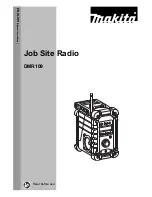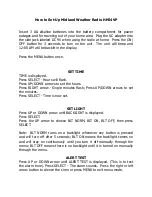
User Manual
Model: BF-888S PLUS
ATTENTION!
You’re BF-888S PLUS SERIES is a multi-task Two Way Radio. Combining the latest technology in radio communication
along with a sturdy mechanical frame, BF-888S PLUS is the ideal and effective solution for the professionals who need to stay in touch
with the working team (in construction sites, buildings, shows, trade fairs or hotels) or for leisure users that just want to keep up with
friends and family.
Before using this product, read the RF Energy Exposure and Product Safety Guide that ship with the radio which contains instructions for safe
usage and RF energy awareness and control for compliance with applicable standards and regulation.
WARNING:
MODIFICATION OF THIS DEVICE TO RECEIVE CELLULAR RADIOTELEPHONE SERVICE SIGNALS IS PROHIBIITED UNDER
FCC RULES AND FEDERRAL LAW.
FCC Part 15.21 Warning Statement
THE GRANTEE IS NOT RESPONSIBLE FOR ANY CHANGES OR MODIFICATIONS NOT EXPRESSLY APPROVED BY THE PARTY RESPONSIBLE
FOR COMPLIANCE. SUCH MODIFICATIONS COULD VOID THE USER’S AUTHORITY TO OPERATE THE EQUIPMENT.
Chapter1. Getting Started
1.1 Regulations and Safety Warnings
FCC Licensing Information
This device complies with Part 90 and 15 of the federal Communications Commission (FCC) Rules.
Operation is subject to the condition that that this device does not cause harmful interference. The radio operates on radio frequencies that are
regulated by the Federal Communications Commission (FCC). To transmit on these frequencies, you are required to have a license issued by the
FCC. To obtain forms, call the FCC forms hotline at: 1-800-418-3676 or go to http://www.fcc.gov For questions concerning commercial licensing,
contact the FCC at 1-888- CALL-FCC (1-888-225-5322).
Before filling out you application, you must decide which frequency you can operate on.
NOTICE: Use of this radio outside the country where it was intended to be distributed is subject to government regulations and may be prohibited.
FCC Regulatory Conformance
FCC Statement
Our radio generators RF electromagnetic energy during transmit mode.This radio is designed for and classified as
“
Occupational Use Only
”
,meaning
it must be used only during the course of employment by individuals aware of the hazards,and the ways To Minimize Such hazards.
This radio is NOT intended for use by the
“
General Population
”
in an uncontrolled environment. This radio has been tested and complies with the
FCC RF exposure limits for
“
Occupational Use Only
”
.
Inaddition, our radio complies with the following Standards and Guidelines with regard to RF energy and electromagnetic energy levels and
evaluation of such levels for exposure to humans:
---IEEE Std. 1528:2013 and KDB447498, Evaluating Compliance with FCC Guidelines for Human Exposure to Radio Frequency Electromagnetic
Fields.
---American National Standards Institute (C95.1-1992), IEEE Standard for Safety Levels with Respect to Human Exposure to Radio Frequency
Electromagnetic Fields, 3 kHz to 300 GHz.
---American National Standards Institute (C95.3-1992), IEEE Recommended Practice for the Measurement of Potentially Hazardous
Electromagnetic Fields-RF and Microwave.
The information listed above provides the user with the information needed to make him or her aware of RF exposure, and what to do to as-sure
that this radio operates with the FCC RF exposure limits of this radio.
Electromagnetic Interference/Compatibility
During transmissions, The radio generates RF energy that can possibly cause interference with other devices or systems. To avoid such interference,
turn off the radio in areas where signs are posted to do so.
DO NOT operate the transmitter in areas that are sensitive to electromagnetic radiation such as hospitals, aircraft,and blasting sites.
Occupational/Controlled Use
The radio transmitter is used in situations in which persons are exposed as consequence of their employment provided those persons are fully
aware of the potential for exposure and can exercise control over their exposure.
This equipment has been tested and found to comply with the limits for a Class B digital device, pursuant to Part 15 of FCC Rules. These limits are
designed to provide reasonable protection against harmful interference in a residential installation. This equipment generates and can radiate
radio frequency energy. If not installed and used in accordance with the instructions, it may cause harmful interference to radio communications.
However, there is no guarantee that interference will not occur in a particular installation. Verification of harmful interference by this equipment to
radio or television reception can be determined by turning it off and then on. The user is encouraged to try to correct the interference by one or
more of the following measures:
- Reorient or relocate the receiving antenna.
- Increase the separation between the equipment and receiver.
- Connect the equipment into an outlet on a circuit different from that to which the receiver is connected.
- Consult the dealer or an experienced radio/TV technician for help.
Changes or modifications not expressly approved by the party responsible for compliance could void the user's authority to operate the
equipment.
This device complies with Part 15 of the FCC Rules. Operation is subject to the condition that this device does not cause harmful interference.
Licensing Information
Use our radio in USA is subject to the rules & regulations of FCC. Changes or modifications not expressly approved by our may void the user
authority granted by the FCC to operate this radio and should not be made. To comply with FCC requirements, transmitter adjustments should be
made only by or under the supervision of a person certified as technically qualified to perform transmitter maintenance and repairs in the private
land mobile and fixed services as certified by an organization representative of the user of those services. Replacement of any transmitter

























